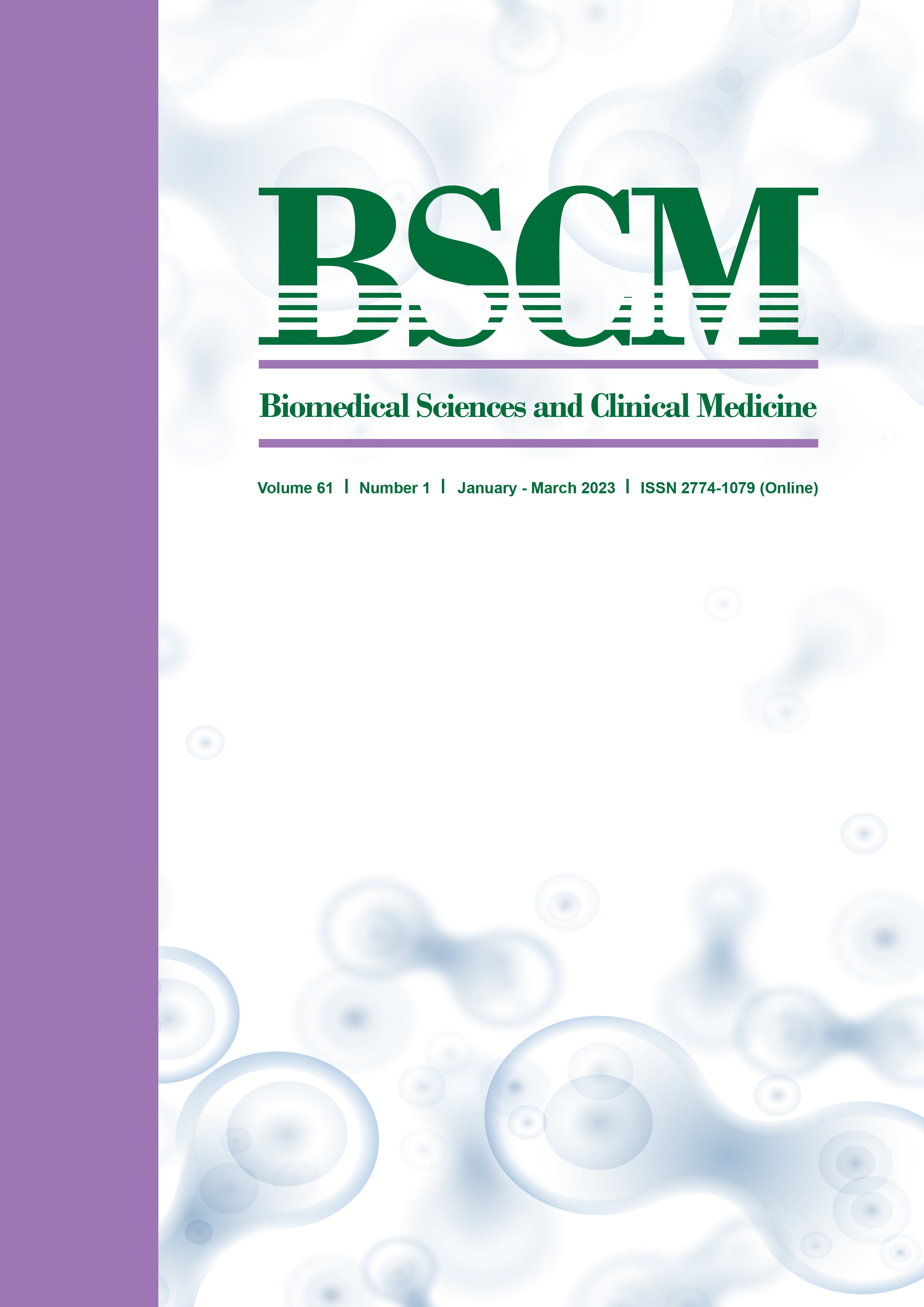การพัฒนาคำพูดสองพยางค์สำหรับการตรวจระดับเริ่มต้นการได้ยินคำพูดในเด็ก
Main Article Content
บทคัดย่อ
วัตถุประสงค์: เพื่อพัฒนาคำพูดสองพยางค์ภาษาไทยสำหรับใช้ในการตรวจระดับเริ่มต้นการได้ยินด้วยคำพูดในเด็ก
วิธีวิจัย: ผู้วิจัยได้พัฒนาคำพูดสองพยางค์ตามหลักการของการพัฒนาคำพูดสาหรับใช้ในการประเมินการ
ได้ยิน ได้แก่ คำที่คุ้นเคยในชีวิตประจำวัน คำทั้งหมดต้องมีความแตกต่างกันในหน่วยเสียง และเป็นคำที่ผู้ฟังรับรู้ได้ที่ความดังใกล้เคียงกัน คำพูดเริ่มต้นถูกนำมาจากบัญชีคำพื้นฐานที่ใช้ในการเรียนการสอนสำหรับภาษาไทยช่วงชั้นที่ 1 โดยนำคำจากมาวิเคราะห์ความดังในแต่ละพยางค์ด้วย CSL จากนั้นผู้ปกครองที่ใกล้ชิดเด็กได้ประเมินความคุ้นเคยของคำพูดเหล่านั้น และขั้นสุดท้ายผู้วิจัยนำคำพูดทั้งหมด 60 คำ ไปหาระดับเริ่มต้นการรับรู้ของแต่ละคำพูด โดยกลุ่มตัวอย่างผู้ฟังเป็นเด็กปกติ จำนวน 30 คน ที่มีการได้ยินและพัฒนาการทางภาษาและการพูดปกติ
ผลการวิจัย: ในจำนวนคำพูดสองพยางค์จำนวน 60 คำ มีคำพูด 25 คำ ที่เป็นคำที่ผู้ฟังรับรู้ได้ที่ความดังใกล้เคียงกัน จากการที่ฟังก์ชันความสัมพันธ์ระหว่างการรับรู้คำได้ถูกต้องกับความดังที่ใช้ในการปล่อยเสียงคำพูดมีค่าความชันมากที่สุด โดยมีค่าเฉลี่ยอยู่ที่ 10.76 %/dB ซึ่งเป็นค่าที่ใกล้เคียงกับผลของการศึกษาอื่น
บทสรุปงานวิจัย: คำพูดสองพยางค์ภาษาไทยสำหรับการตรวจระดับเริ่มต้นการได้ยินคำพูดในเด็กนี้ ถูกพัฒนาขึ้นตามเกณฑ์การพัฒนาคำพูดสำหรับการประเมินการได้ยิน ดังนั้นบัญชีคำพูดสองพยางค์นี้จึงสามารถนำไปใช้ประเมินระดับเริ่มต้นการได้ยินด้วยคำพูดในเด็กได้
Article Details

อนุญาตภายใต้เงื่อนไข Creative Commons Attribution 4.0 International License.
เอกสารอ้างอิง
Wittkowsky AK. Warfarin and other coumarin derivatives: pharmacokinetics, pharmacodynamics, and drug interactions. Semin Vasc Med. 2003;3:221-30.
Ansell J, Hirsh J, Poller L, Bussey H, Jacobson A, Hylek E. The pharmacology and management of the vitamin K antagonists: the Seventh ACCP Conference on Antithrombotic and Thrombolytic Therapy. Chest. 2004;126:204s-33s.
Miners JO, Birkett DJ. Cytochrome P4502C9: an enzyme of major importance in human drug metabolism. Br J Clin Pharmacol. 1998;45:525-38.
Ansell J, Hirsh J, Hylek E, Jacobson A, Crowther M, Palareti G. Pharmacology and management of the vitamin K antagonists: American College of Chest Physicians Evidence-Based Clinical Practice Guidelines (8th Edition). Chest. 2008;133:160s- 98s.
Balfour JA, McTavish D, Heel RC. Fenofibrate. Drugs. 1990;40:260-90.
Polnak JF, Delate T, Clark NP. The influence of fibrate initiation on INR and warfarin dose in patients receiving chronic warfarin therapy. J Thromb Thrombolysis. 2018;46:264-70.
Leonard CE, Brensinger CM, Bilker WB, Kimmel SE, Han X, Nam YH, et al. Gastrointestinal bleeding and intracranial hemorrhage in concomitant users of warfarin and antihyperlipidemics. Int J Cardiol Heart Vasc. 2017;228:761-70.
Ascah KJ, Rock GA, Wells PS. Interaction between fenofibrate and warfarin. Ann Pharmacother. 1998;32:765-8.
Guo C, Xue S, Zheng X, Lu Y, Zhao D, Chen X, et al. The effect of fenofibric acid on the pharmacokinetics and pharmacodynamics of warfarin in rats. Xenobiotica. 2018;48:400-6.
El-Helou N, Al-Hajje A, Ajrouche R, Awada S, Rachidi S, Zein S, et al. Adverse drug events associated with vitamin K antagonists: factors of therapeutic imbalance. Vasc Health Risk Manag. 2013;9:81-8.
Juurlink DN. Drug interactions with warfarin: what clinicians need to know. CMAJ. 2007;177:369-71.
Balfour JA, McTavish D, Heel RC. Fenofibrate. A review of its pharmacodynamic and pharmacokinetic properties and therapeutic use in dyslipidaemia. Drugs. 1990;40:260-90.
Kim KY, Mancano MA. Fenofibrate potentiates warfarin effects. Ann Pharmacother. 2003;37:212-5.
Breault R, Klakowicz A, George-Phillips K, Bungard T. Warfarin dosing after initiation of fenofibrate. Can J Hosp Pharm. 2005;58.
Aldridge MA, Ito MK. Fenofibrate and Warfarin Interaction. Pharmacotherapy. 2001;21:886-9.


